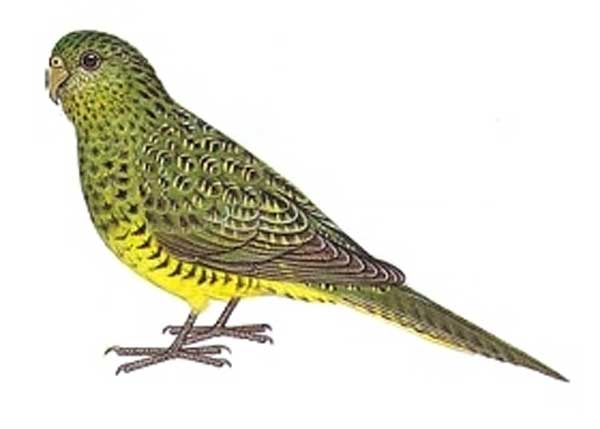Geopsittacus occidentalis Cladus: Eukaryota Name Geopsittacus occidentalis Gould, 1861 Vernacular names The Night Parrot or Snub Nosed Parrot (Pezoporus occidentalis) is a small broad-tailed parrot endemic to the continent of Australia. The species was originally placed within its own genus (Geopsittacus),[1][2] but most authors now prefer to place it within the genus Pezoporus together with the two ground parrots.[3] No known sightings of the bird were made between 1912 and 1979, leading to speculation that it was extinct. Sightings since 1979 have been extremely rare and the bird's population size is unknown. Description A relatively small parrot, the species' colour is predominantly a yellowish green, mottled with dark brown, blacks and yellows. It is distinguished from the two superficially similar ground parrot species by its shorter tail and different range and habitat. Predominantly terrestrial, taking to the air only when panicked or in search of water, the Night Parrot has furtive, nocturnal habits and—even when it was abundant—is apparently a highly secretive species. Its natural habitat appears to be the spinifex grass which still dominates much of the dry, dusty Australian interior; other early reports also indicate that it never strayed far from water. Conservation status The population size of this species is not known. Estimates range from extinct to not threatened at all. It is currently listed on the IUCN Red List as Critically Endangered. There have been only a few reliable records of the bird since the 1880s, with the last authenticated report dating from 2006, when rangers found a dead specimen which had flown into a barbed wire fence in the Diamantina National Park in south western Queensland.[4][5][6] Prior to this, the last reliable sighting was of three individuals in 2005 near Minga Well, in the Pilbara region of Western Australia.[6][7] Reliable sightings were made in 1990 when a roadkill specimen was discovered by scientists returning from an expedition in a remote part of Queensland[6][8] and 1979 when Ornithologist Shane A. Parker from the South Australian Museum spotted an apparent flock of the birds in the far north of South Australia.[9] Ornithologists continue to patrol the outback for signs that the species still thrives, even checking the old nests of other birds, such as the Zebra Finch, for fragments of Night Parrot feathers. The Night Parrot remains one of the most elusive and mysterious birds in the world of ornithology. Sightings at Minga Well The approval of the A$2billion Cloud Break mine project through the then-Minister for the Environment, Ian Campbell, was criticised because of a number of endangered species in the area of the future mine, among them the Night Parrot.[10] In order to gain EPA approval, the mine had to implement a management plan to ensure that mining activities would not have a negative effect on the species survival in the area. The occurrence of the Night Parrot in the future mining area, at Minga Well on 12 April 2005, was discovered during a 2005 survey commissioned by FMG, which was carried out by two contract biologists who sighted a small group of the birds. Unconfirmed sightings of the bird had been made previously in a near-by area in 2004.[11][12] The sighting, at dusk in poor light conditions, was done by biologists Robert Davis and Brendan Metcalf, who were not able to obtain a photograph of the three birds they saw, but are nevertheless fully confident that they spotted three Night Parrots. The two biologists carried out further searches at Minga Well and Moojari Well the following five nights but were unable to spot the birds again.[11] A follow up survey of the Fortescue Marsh area in May 2005 was unsuccessful in finding any conclusive evidence of the species.[13] List of sightings * April 2005, Pilbara region of Western Australia and near the Fortescue Marshes[7]
1. ^ Forshaw, Joseph M. & Cooper, William T. (1981). Parrots of the World (3rd ed). Press, Willoughby, Australia. * BirdLife International (2004). Pezoporus occidentalis. 2006. IUCN Red List of Threatened Species. IUCN 2006. www.iucnredlist.org. Retrieved on 25 September 2006. Database entry includes justification for why this species is critically endangered. * Weidensaul, S. (2002). The Ghost with Trembling Wings: Science, Wishful Thinking, and the Search for Lost Species, North Point Press (New York), ISBN 0-86547-668-3, pp. 75–81. Source: Wikipedia, Wikispecies: All text is available under the terms of the GNU Free Documentation License |
|

